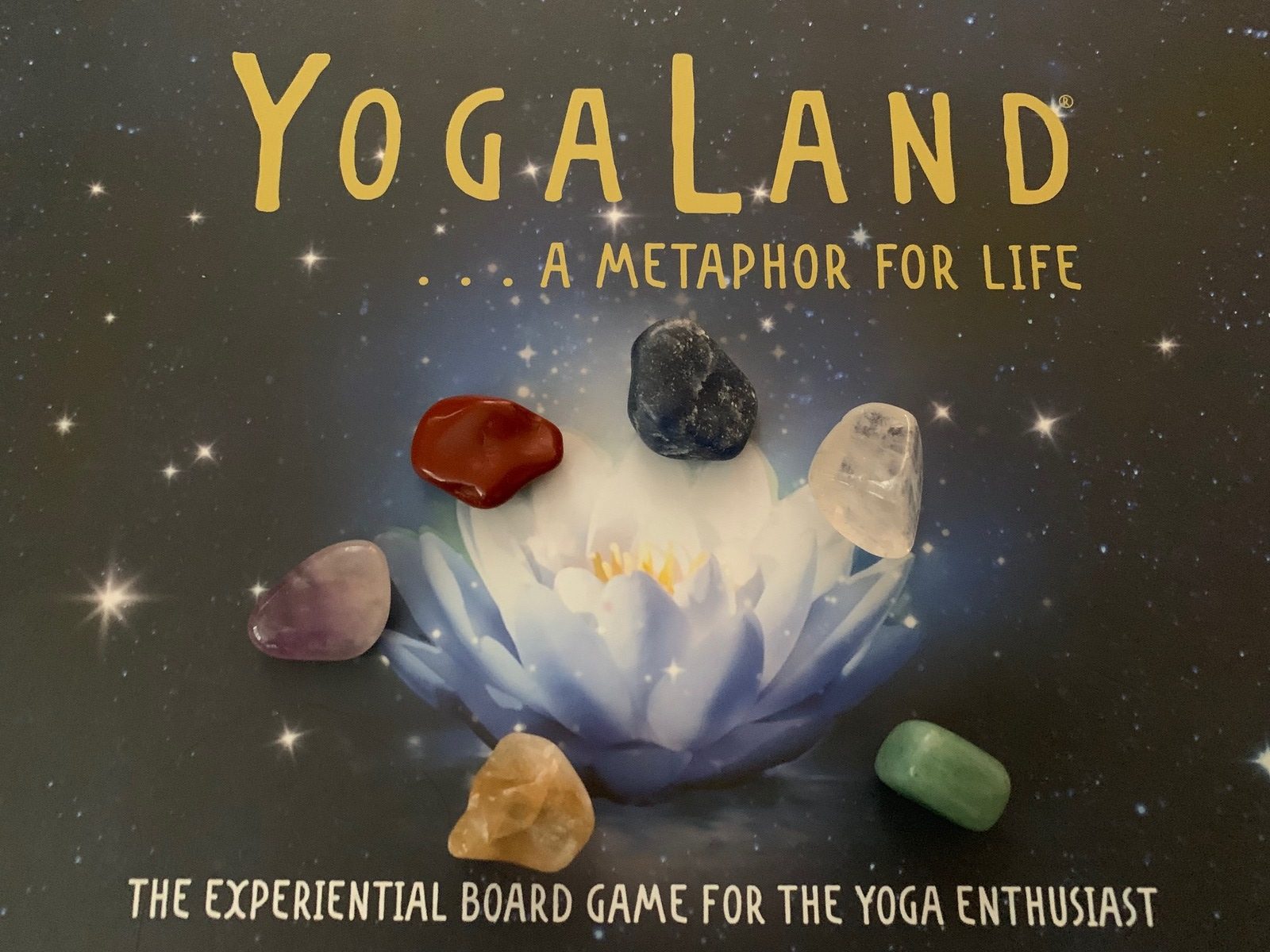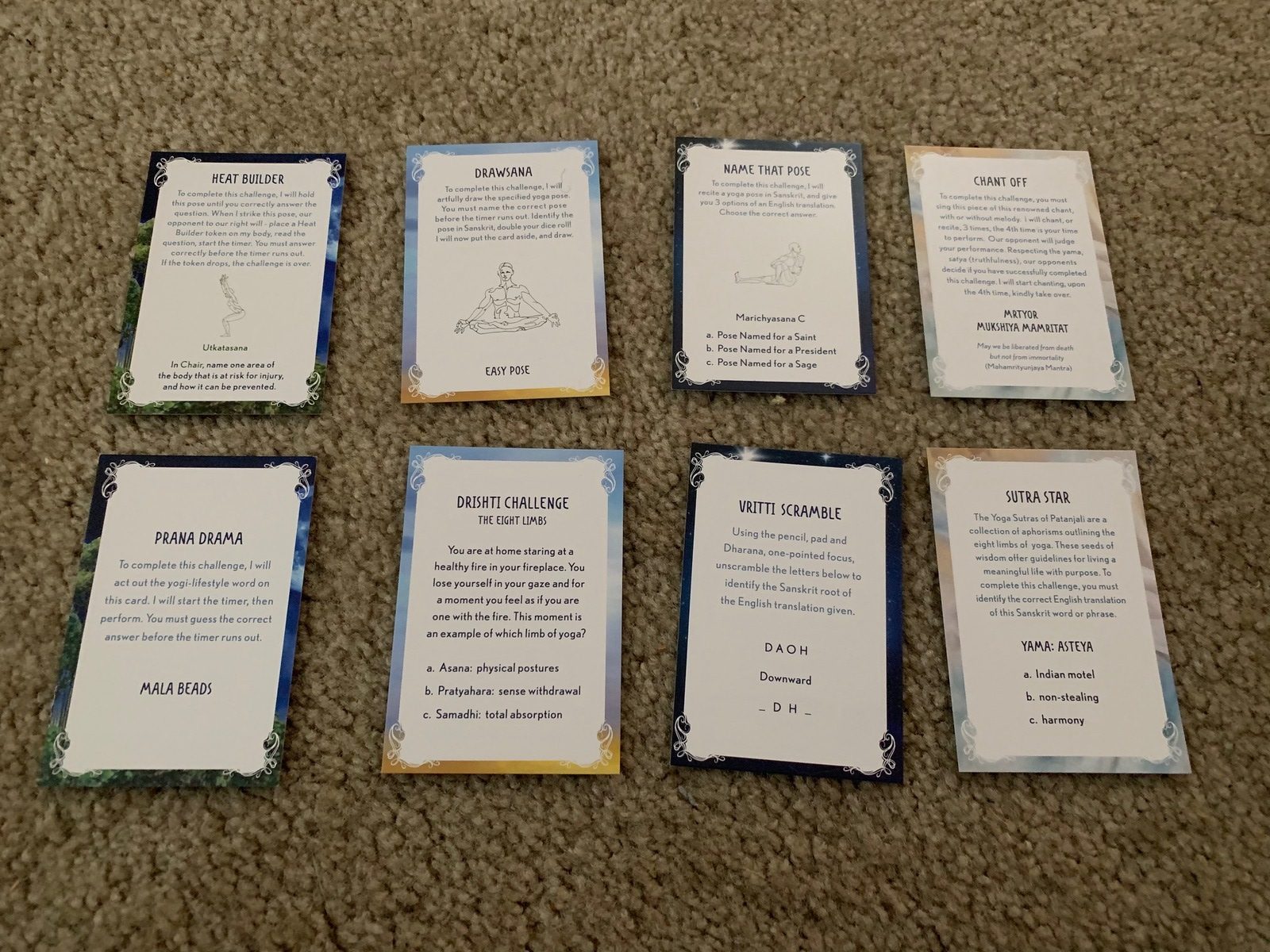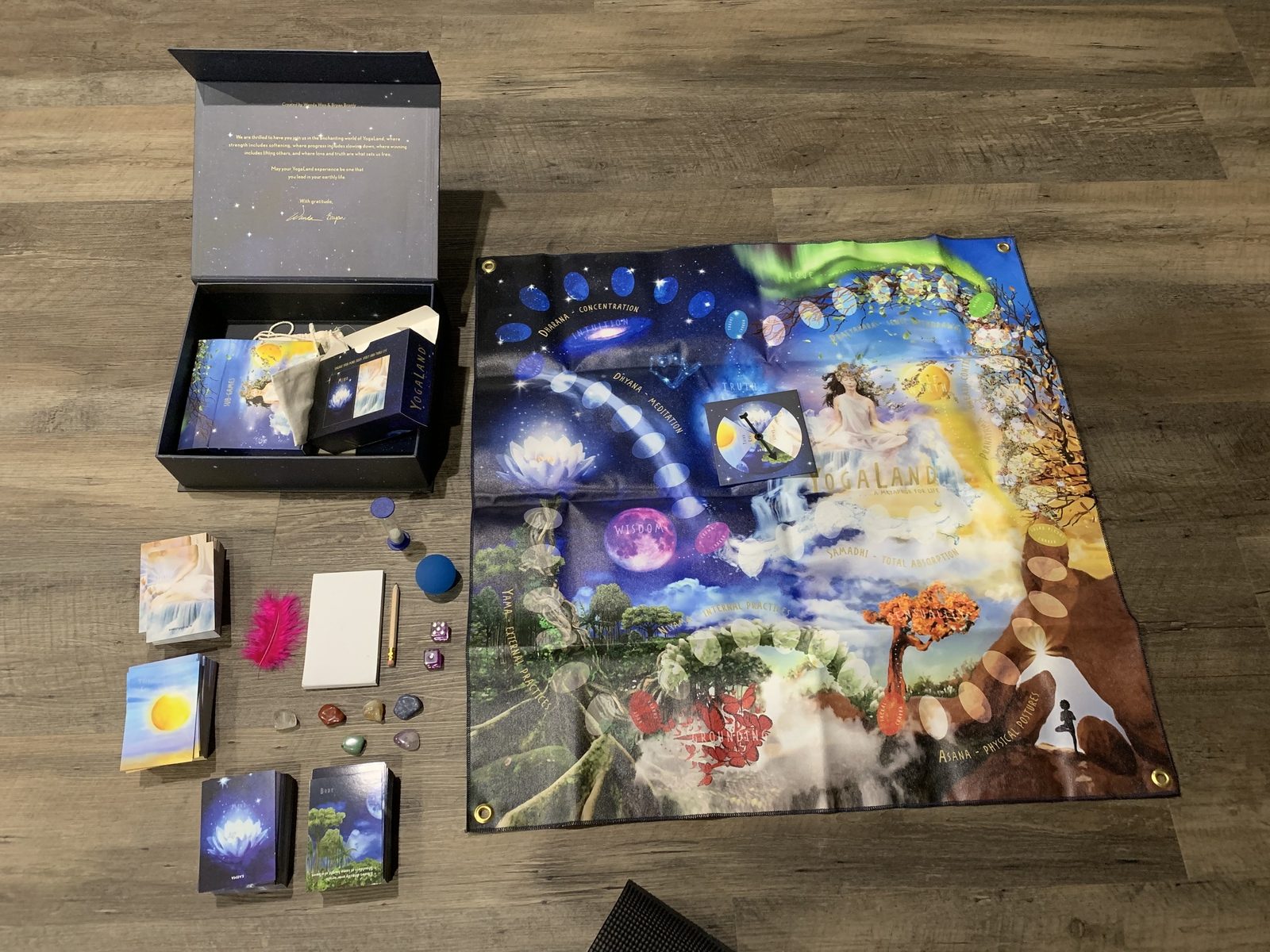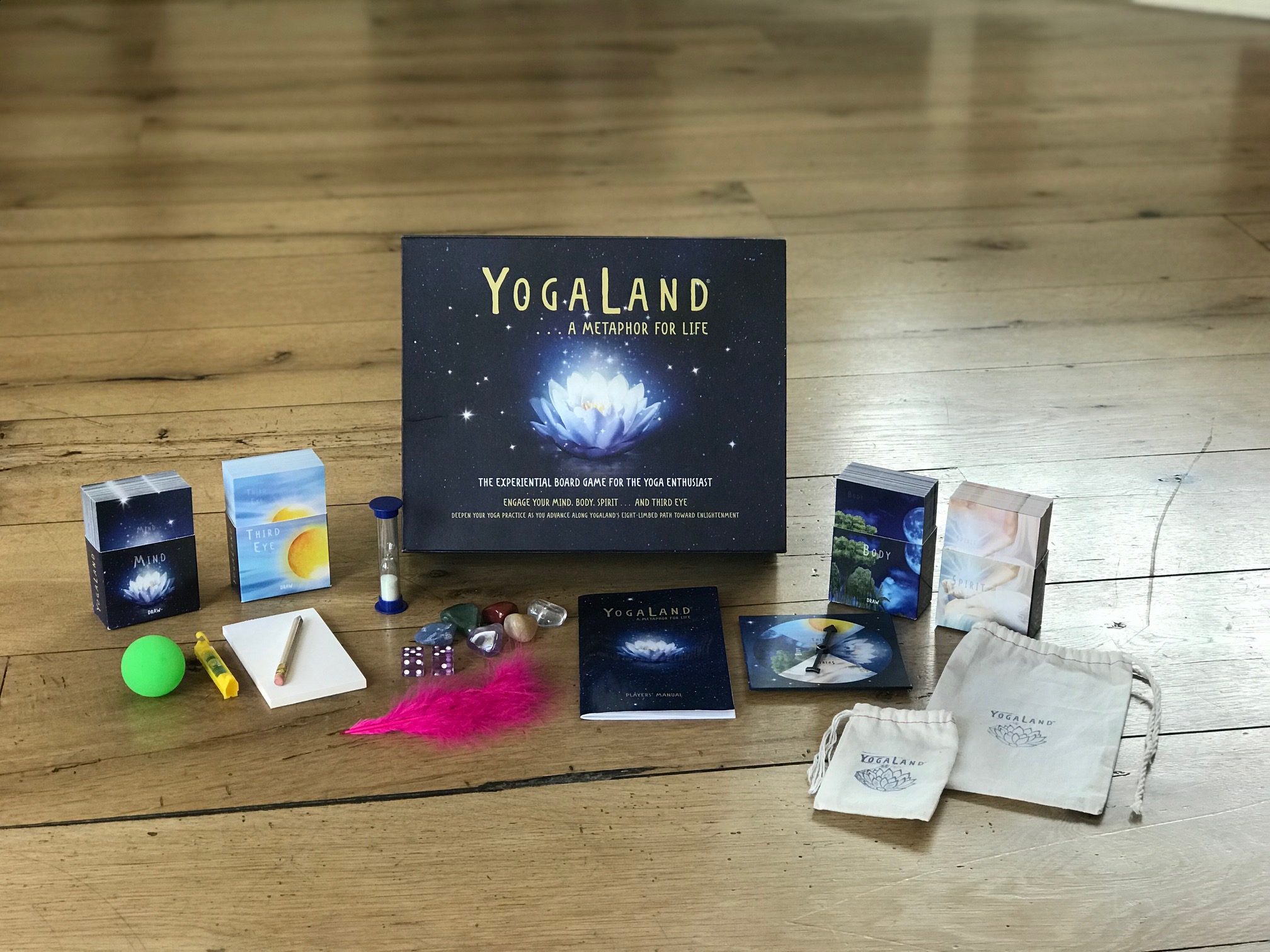When you think of yoga, meditation, and things associated with them, the word “board game” isn’t something that immediately springs to mind. That’s not to say that it couldn’t happen; I’m a firm believer that inspiration for yoga and meditation can come from a variety of places. But a board game, in general, isn’t something you traditionally think of when you think about a yogic lifestyle and the traditions associated therein. However, in recent years, with yoga becoming more mainstream, plenty of teachers like me are often pleasantly inspired with what new ideas related to yoga come out of the woodwork each year.
In that vein, the past few months have brought us Yogaland, a board game in the vein of popular games like “Candyland” or “Chutes and Ladders.” It aims to help you ‘practice your poses, awaken your senses, sharpen your Sanskrit, clean your chakras, balance your breathing, cultivate compassion, fine-tune your philosophy, move towards mindfulness, and laugh your asana off!’
That’s quite a laundry list of promises that I, as a practicing yogi and avid gamer, was initially skeptical of. This was especially true when it ranked in a Forbes list of popular gifts for yogis issued during the holidays.

Yogaland is the creation of Wanda Wen, Bryan Branly, and E. Ashley Dean, all avid teachers and passionate about yoga. The concept for the game came from looking for a way to help students better remember material taught to them over their teaching certification. Thus, they set out to create a fun experience to engage all parts of the body (physical, mental, and spiritual) and bring the concepts of the Eight Limbs of Yoga to a wider audience.
In the past few weeks, I was able to play this game with several of my yogi friends in various levels and give it a try. Our goal was to see if it lived up to what it set out to do and how enjoyable it was.
Presentation:
Upon opening the box itself, I was immediately struck by the great quality of the game. So often new and upcoming board games, especially from newer places and people, tend to be shoddy, lackluster, or lacking in sturdiness with how it was made. Yogaland thankfully doesn’t have this problem as the box, mat, and materials are not only made with love but are portable enough so transporting them is not a problem.
The game board is a large, easy to fold canvas mat and there are plenty of cloth pouches provided to store things without damage. Every item used, from the mat to the game pieces (stones related to the chakras), from the spinner to the instruction booklet, were obviously made with care. That strength in its making makes the game feel legitimate.

The visual flair of the game is also outright stellar; great effort was put into its style and design. Everything from the gorgeous artwork on the board itself to the more subtle card designs, and especially the vibrant colors, truly make everything pop and stand out. Yogaland was obviously crafted with immense love and intention to reflect its quality. It feels like a yogic treasure trove for players to dig into and I was glad to see that these smaller details weren’t overlooked.
Rules and Gameplay:
A well-made game, however, is nothing without great gameplay and thankfully Yogaland mostly succeeds here too. In terms of core mechanics, it doesn’t do anything too different. It involves teams of two players competing against each other and moving their way from one end of the board to the other. The ultimate goal is to appropriately reach the Spirit of Samadhi, representing the established form of enlightenment from the Eight Limbs of Yoga.
But the challenges you have to do in order to get there are where the gameplay truly shines.
Each turn involves spinning for a category (mind, body, spirit, and third eye), picking a card from that category, and then performing the challenge the card stipulates with your teammate. Upon success, you then move forward a number of spaces determined by a dice roll.
It’s a nice little shake-up of the traditional roll-and-move formula: moving forward is more determined by skill than by luck. The fact that you aren’t allowed to move forward until after you succeed at the challenge means that players are encouraged to band together and build their knowledge in order to succeed. This works exceptionally well as a method for students of yoga and meditation to have fun while testing them in what they’ve been learning.

In addition to these challenges, players have a chance to land on spaces related to the 7 chakras that question them with introspective discussion to ‘clear their energy.’ Each chakra has specific inquiries associated with them that players must discuss with each other before moving forward. These moments relate to the chakra in question but also have the potential to bring out healing and growth in each person playing. After discussion, the other players collaborate and decide if what was discussed was done so with an open heart. That determines whether they move forward on the mat.
It felt very organic, special, and in the end surprisingly meaningful, but it is a tad flawed in some respects.
This was by far the favorite part of the game for the group I was with. It felt very organic, special, and in the end surprisingly meaningful, but it is a tad flawed in some respects. It feels a little too subjective of a mechanic for a game as there are many different ways to determine whether someone truly answered from the heart. The chakras were also double-edged swords in that their mechanics were a little unclear.
We were never 100% sure whether we were supposed to stop at each one or pass over them depending on how high the number on the dice was compared to our placement on the board. We ended up trying both ways over the course of playing and found that whenever we passed them all together because of the dice roll, we felt unfulfilled. It felt like we were missing a necessary part of the journey to reach Samadhi.

When we started stopping at each chakra when a team landed on them even if the dice roll led us farther, this worked a bit better but caused several other problems. They quickly became repetitive, and we rapidly ran out of the questions associated with each chakra. It also significantly lengthened the game by extreme amounts to where one game would take several hours. This mechanic could’ve used a bit of balancing in order to find the right mix between length and intention or a little bit better explanation as to how it was meant to work. But the meaning behind it is very well done, and it does ultimately serve the intended purpose.
There are also tiny little mechanics here and there such as the “Nama-steal” rule and the “do or dana?” question, but these are things best left to be discovered. All in all though, the gameplay and structure of Yogaland are very solid, coming from many different inspirations that have been adapted to suit its content and meaning.
Content:
With Yogaland, the creators of the game had an infinity of yogic knowledge, meditative inspiration, and plenty of small details to work with. So it surprises me that out of all of the qualities of the game, the content is the weakest link in the sum of its parts. Now, this isn’t to say that there isn’t a good amount of content, far from it.
The game covers a staggering variety and is full of details that I wasn’t even aware of when I went through my teaching. In that sense, the game works both as a nice refresher and a great teaching tool.
As a part of the mechanics, the game presents eight types of challenges (two for each category):
MIND
- “Name That Pose” – Multiple choice questions that ask a player to give an English translation of a pose given in Sanskrit.
- “Vritti Scramble” – Timed scramble challenge to create a Sanskrit root word given the letters and one or two hints in regards to order.
BODY
- “Heat Builder” – Holding a yoga pose while being asked a question about alignment, muscle movement, and risk factors of the asana.
- “Prana Drama” – Charades with yoga lifestyle objects and words.
SPIRIT
- “Sutra Star” – Multiple choice question with concepts from the Yoga Sutras.
- “Chant Off” – Singing a Sanskrit chant and being judged based on quality and response.
THIRD EYE
- “Drawsana” – One member of each team guesses an asana based on a drawing done by the other team member.
- “Drishti Challenge” – Multiple choice question with concepts from the Eight Limbs of Yoga.

All of these concepts are extremely clever, and I can imagine a great deal of time and energy went into imagining them. The problem, unfortunately, comes from their execution. They all definitely encourage learning and experience from both students and instructors, but many of them aren’t entirely suited to all levels. Many people playing with our group had never heard of things like the Sutras or didn’t know the meaning of many of the Sanskrit words that are so integral to yogic tradition.
Thus, they were at a severe disadvantage playing with people who were not only familiar with them but incorporated them daily into their practice and teaching.
Because there were multiple cases where people didn’t feel like they could compete with more experienced practitioners in the group (even despite the yogic concept of non-judgment), teams had to be structured a very specific way. This ensured there was an even level of competition. Many challenges like the “Drishti Challenge,” “Vritti Scramble,” “Sutra Star,” and even the “Heat Builder” felt like easy wins for some and extremely challenging, if not completely unfair, to others.
To be fair, the creators of the game clearly knew that this might be an issue and so allowed for a clause that removes the Mind and Spirit categories completely from gameplay. This does help considerably but doesn’t quite solve the issue entirely. Many of the questions from the Body and Third Eye categories still proved difficult, particularly when it came to body alignment and the Eight Limbs. It also made the game way too easy for more experienced players especially with some of the options for the multiple choice questions feeling way too obvious.

Some of the writing feels a tad shoehorned in to make correct answers easier to spot and it never felt like there was a good middle ground between experienced and newcomers. Adding in levels of difficulty (easy, medium, and hard, for example) with both challenges and cards would’ve gone a very long way in making the game more fun for everyone playing.
Overall playability and lessons:
On the whole, Yogaland is a perfect representation of exactly what it says on the box: a game to work with your asanas, sharpen your yogic intellect, and get more in touch with your practice as a result. In that sense, it does mostly succeed, and many yogis are going to get a major kick out of it. As an overall game, it has a very solid base with a strong intention, purpose, and structure.
However, it does suffer in terms of balance and energy, and the lack of a strong middle ground means that I don’t see this game as suitable for all yogis, even with the rules the creators tried to add. The caveat that the game and creators give saying that ‘Basic knowledge of yoga and some Sanskrit is helpful’ doesn’t quite match what’s here; knowledge of yoga and Sanskrit is absolutely essential. These problems make it hard to recommend Yogaland for everyone, and if you are brand new to yoga and meditation or are only a casual practitioner, you might want to give it a tentative pass. However, with a little bit of time, readjusting, and work on making things more accessible, this could easily be a must have for all those engaged in yoga.

As a potential yoga game night or as a tool for students and teachers, however, Yogaland is a major creative success. This is a great yoga gift and particularly recommended for those in the middle of the teacher training. But it’s also fun for those who already have a basic knowledge of what yoga means beyond the physical asanas and as a refresher for the more experienced, as a reminder of what they’ve learned.
If all of this piques your interest, check out the website for more information. You can also order the game at the retail price of around $80. I personally really enjoyed it despite its flaws and will be returning to it with several of my yoga friends in the future. So why not take a chance and see where it leads you on your yoga journey?
Editor’s note: We got in touch with the creators of Yogaland to ask about the reason behind the use of Sanskrit and here is what they replied: “In modern day, Sanskrit is establishing a more solid place within the yoga world. Our desire is to see its continued use as we feel it is vital to upholding yoga’s rich and sacred heritage. Our efforts in integrating Sanskrit words within YogaLand is a playful yet respectful attempt to weave in these unfamiliar words to many in a way that fosters understanding of this ancient language.”
Edited by Ely Bakouche



